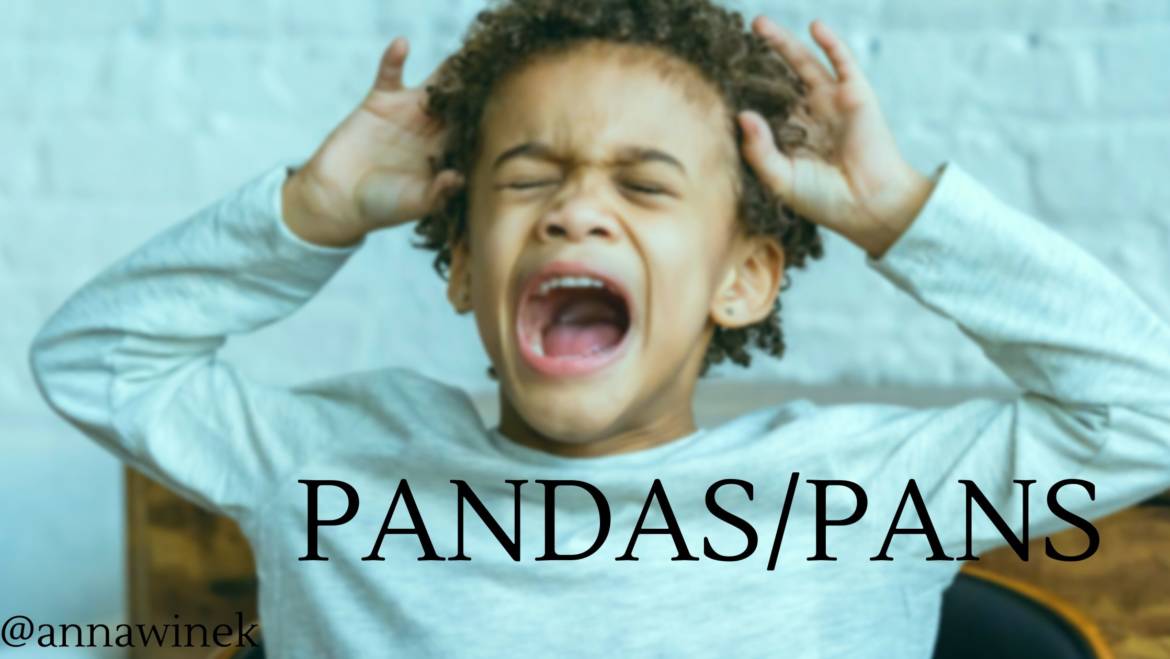When children suddenly stop eating, it can be a sign of a condition called PANDAS/PANS. This condition is known for causing not only obsessive-compulsive symptoms but also a sudden decrease in food intake. Let’s break down what this means in simpler terms.
What is PANDAS/PANS?
PANDAS (Pediatric Autoimmune Neuropsychiatric Disorder Associated with Streptococcal Infections) and PANS (Pediatric Acute-Onset Neuropsychiatric Syndrome) are conditions that affect some children. They can cause kids to have unusual behaviours and thoughts. In PANDAS, the symptoms often happen after a strep infection, like a sore throat. In PANS the sudden onset of obsessive-compulsive symptoms (OCD) and/or eating restrictions following a bacterial or viral infection, including COVID-19.
Why Do Some Kids Stop Eating?
In PANDAS/PANS, some children develop a fear of eating. They might worry about germs in their food or fear choking. This fear can be so strong that they refuse to eat anything, even drink liquids. Some kids may also have worries about their body shape.
How Common is This?
It’s not very common, but it happens. In the Disordered Eating and Food Restrictions in Children with PANDAS/PANS study, researchers looked at 29 kids with PANS who had food challenges. Most of them were afraid of contamination, like germs or poison. Some were worried about vomiting or choking. A few also had body image concerns.
What Causes It?
In some cases, it’s linked to infections like strep or Mycoplasma pneumonia. These infections might make the immune system act strangely and affect the brain. Some scientists think that the body’s immune system can start attacking the brain, causing these food issues.
The Role of Autoantibodies
Autoantibodies are like tiny soldiers in our bodies. Sometimes, in PANDAS/PANS, they might mistakenly attack parts of the brain, causing these unusual behaviours. It’s like a mix-up in the body’s messaging system.
Similar to Other Eating Disorders
These food issues might seem like eating disorders, but they’re a bit different. They’re called Avoidant and Restrictive Food Intake Disorder (ARFID) and can go hand-in-hand with OCD or other conditions.
Other Symptoms:
Along with food worries, these kids might have trouble sleeping, feel anxious, or have strange movements.
Boys and Girls:
PANDAS/PANS can affect both boys and girls, but it seems to happen more often in boys.
How Do We Treat It?
Treating PANDAS/PANS is different from treating regular eating disorders. Antibiotics or other medicines can often help. It’s important to find the right treatment for each child because it can make a big difference.
Here I present some selected cases that shed more light on this complex condition.
Patient 8 – The Fear of Contamination
Patient 8 was an 8-year-old boy who developed severe contamination fears, food refusal, and tics one month after experiencing a viral infection with gastrointestinal symptoms. He had a history of frequent GAS infections and had even undergone adenotonsillectomy due to these infections. The fear of dying suddenly while eating at a restaurant triggered his panic attack. He started refusing to eat solid food, fearing allergens and medication contamination. His mother tried giving him fake allergy pills to encourage him to eat, but his contamination fears worsened, limiting him to clear liquids. Treatment with azithromycin helped him overcome his worries, and he returned to normal eating within a month.
Patient 12 – The Bleach Contamination Fear
Patient 12, a 10-year-old boy with a history of ADHD, developed sudden and severe OCD along with a fear that his hands and lips were contaminated with bleach cleaner. He had tested positive for GAS and had been exposed to family members who also had GAS infections. His fear of bleach contamination extended to his food, and he began spitting out or throwing away any food that touched his hands or lips. He would only eat food cut into specific shapes to avoid contamination. He eventually stopped eating altogether. Treatment with penicillin and IVIG led to a significant improvement in his symptoms.
Patient 13 – The Perfectionism and Moral Concerns
Patient 13, an 8-year-old girl, developed OCD symptoms, including confessing excessively, concerns about right and wrong, and contamination fears, after being exposed to GAS at school. Although she tested negative for GAS pharyngitis, her ASO and anti-DNAse B levels were elevated. She developed an obsession with being “bad” or “wrong” and refused to eat treats, believing she didn’t deserve them. Treatment with amoxicillin, amoxicillin-clavulanic acid, and IVIG helped her recover, with slight residual generalized anxiety.
Patient 24 – The Fear of Vomiting
Patient 24, a 7-year-old girl with no previous medical or psychiatric history, suddenly developed OCD symptoms, including a compulsive need to carry a plastic bucket due to fears of vomiting and choking. She also began refusing to eat for three consecutive days. Rapid GAS tests were negative initially, but treatment with amoxicillin significantly improved her symptoms. However, her symptoms returned after exposure to a relative with a GAS infection. Amoxicillin and a brief course of azithromycin were continued, leading to symptom reduction.
These selected cases highlight the diverse ways PANDAS/PANS can affect children, causing them to develop intense fears, obsessions, and food restrictions. Early diagnosis and appropriate treatment are crucial for helping these children recover and lead healthier lives.
Conclusion
If your child suddenly stops eating or has strange food fears, it’s essential to talk to a doctor. They can help figure out if it’s PANDAS/PANS or something else. Early diagnosis and treatment can help these kids get better and lead healthier lives.
Reference: Disordered Eating and Food Restrictions in Children with PANDAS/PANS

